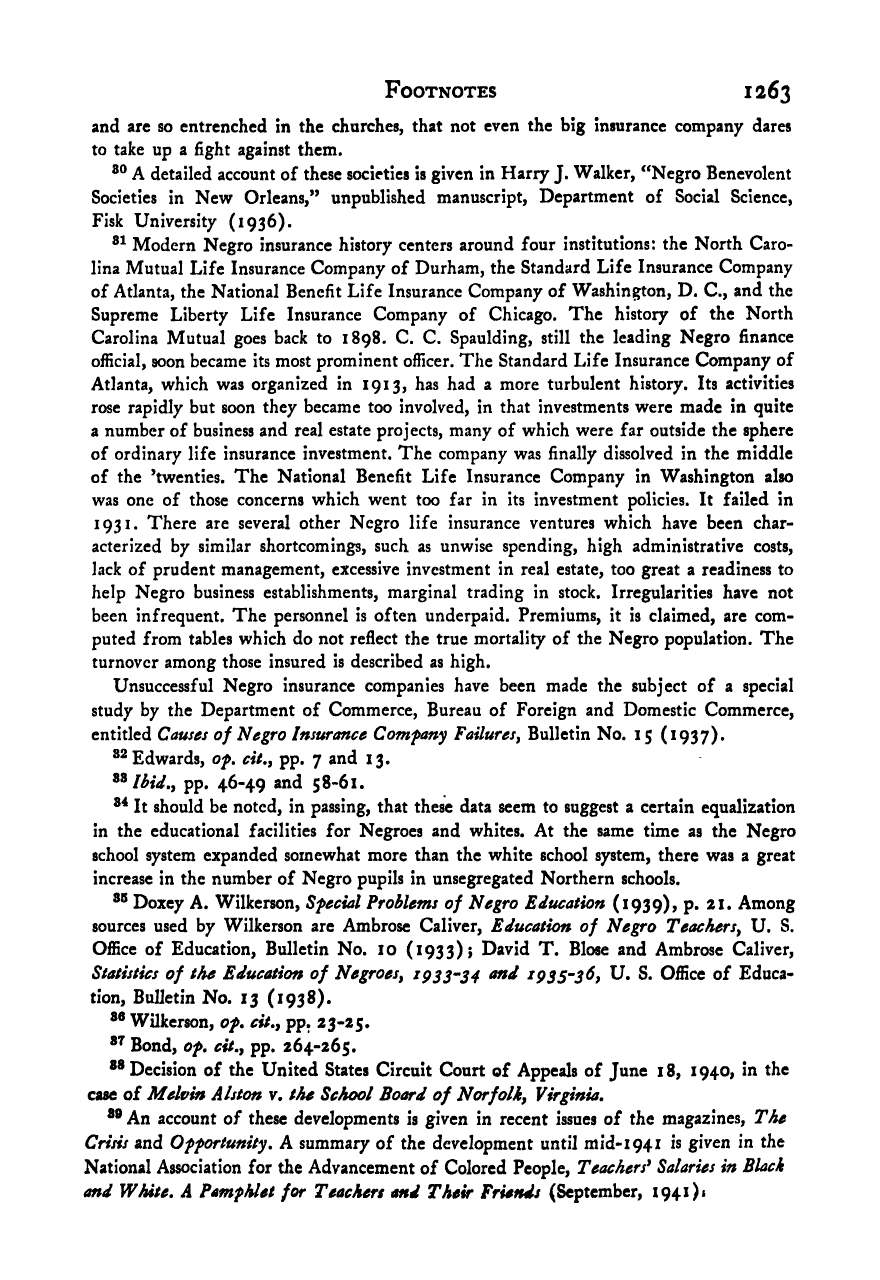Note: Gunnar Myrdal died in 1987, less than 70 years ago. Therefore, this work is protected by copyright, restricting your legal rights to reproduce it. However, you are welcome to view it on screen, as you do now. Read more about copyright.
Full resolution (TIFF) - On this page / på denna sida - Footnotes - Chapter 14

<< prev. page << föreg. sida << >> nästa sida >> next page >>
Below is the raw OCR text
from the above scanned image.
Do you see an error? Proofread the page now!
Här nedan syns maskintolkade texten från faksimilbilden ovan.
Ser du något fel? Korrekturläs sidan nu!
This page has never been proofread. / Denna sida har aldrig korrekturlästs.
Footnotes 1263
and are so entrenched in the churches, that not even the big insurance company dares
to take up a fight against them.
A detailed account of these societies is given in Harry J. Walker, “Negro Benevolent
Societies in New Orleans,” unpublished manuscript. Department of Social Science,
Fisk University (1936).
Modern Negro insurance history centers around four institutions: the North Caro-
lina Mutual Life Insurance Company of Durham, the Standard Life Insurance Company
of Atlanta, the National Benefit Life Insurance Company of Washington, D. C., and the
Supreme Liberty Life Insurance Company of Chicago. The history of the North
Carolina Mutual goes back to 1898. C. C. Spaulding, still the leading Negro finance
official, soon became its most prominent officer. The Standard Life Insurance Company of
Atlanta, which was organized in 1913, has had a more turbulent history. Its activities
rose rapidly but soon they became too involved, in that investments were made In quite
a number of business and real estate projects, many of which were far outside the sphere
of ordinary life insurance investment. The company was finally dissolved in the middle
of the ’twenties. The National Benefit Life Insurance Company in Washington also
was one of those concerns which went too far in its investment policies. It failed in
1931. There are several other Negro life insurance ventures which have been char-
acterized by similar shortcomings, such as unwise spending, high administrative costs,
lack of prudent management, excessive investment in real estate, too great a readiness to
help Negro business establishments, marginal trading in stock. Irregularities have not
been infrequent. The personnel is often underpaid. Premiums, it is claimed, are com-
puted from tables which do not reflect the true mortality of the Negro population. The
turnover among those insured is described as high.
Unsuccessful Negro Insurance companies have been made the subject of a special
study by the Department of Commerce, Bureau of Foreign and Domestic Commerce,
entitled Causes of Negro Insurance Comfany Failures, Bulletin No. 15 (1937).
Edwards, of, cit,, pp. 7 and 13,
Ibid,, pp. 46-49 and 58-61.
It should be noted, in passing, that these data seem to suggest a certain equalization
in the educational facilities for Negroes and whites. At the same time as the Negro
school system expanded somewhat more than the white school system, there was a great
increase in the number of Negro pupils in unsegregated Northern schools.
Doxey A. Wilkerson, Sfecial Problems of Negro Education (1939), p. 21. Among
sources used by Wilkerson are Ambrose Caliver, Education of Negro Teachers, U. S.
Office of Education, Bulletin No. 10 (1933); David T. Blose and Ambrose Caliver,
Statistics of the Education of Negroes, ips3’^S4 and 1935-3 6, U. S. Office of Educa-
tion, Bulletin No. 13 (1938).
Wilkerson, of. cit,, pp, 23-25.
Bond, Of, cit,, pp, 264-265.
Decision of the United States Circuit Court of Appeals of June 18, 1940, in the
case of Melvin Alston v. the School Board of Norfolk, Virginia,
An account of these developments is given in recent issues of the magazines. The
Crisis and Offortunity, A summary of the development until mid- 1941 is given in the
National Association for the Advancement of Colored People, Teachers^ Salaries in Black
and White, A Pamfhlet for Teachers and Their Friends (September, 1941)*
<< prev. page << föreg. sida << >> nästa sida >> next page >>